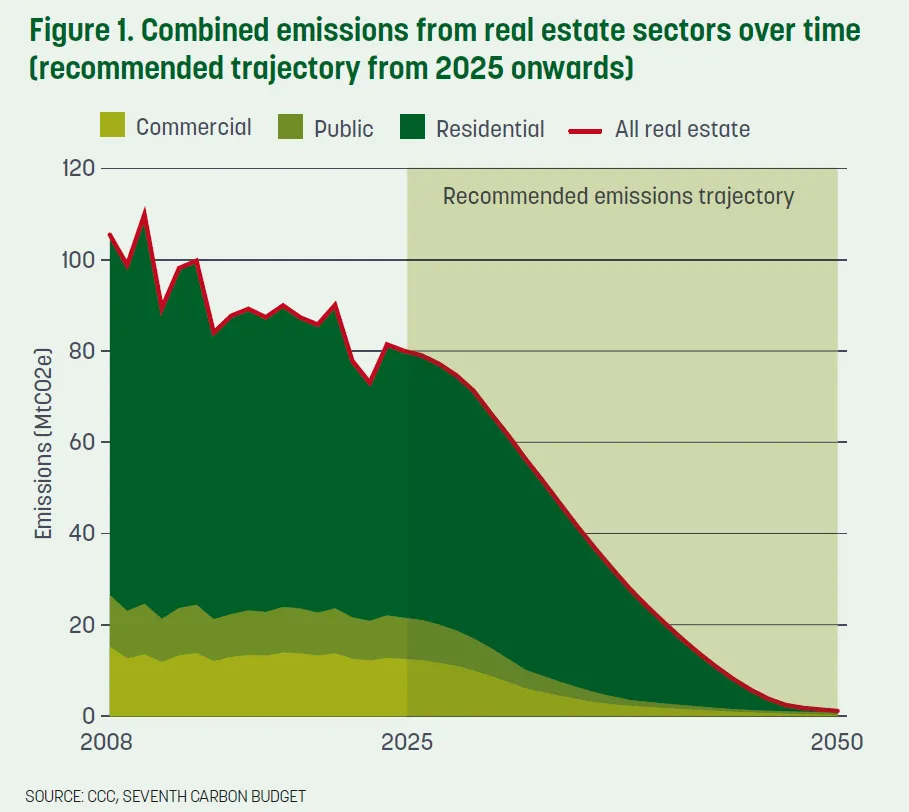The Climate Change Committee (CCC), established to advise government on meeting its net zero targets, published its seventh carbon budget and policy recommendations at the end of February.

Allan Wickham is global integrated sustainability director at CBRE UK
While not every recommendation will become policy, they show what is required for real estate to decarbonise and help the UK meet its 2050 net zero commitment.
In the 2030s, this could include stricter energy efficiency regulations for rented property, stricter building regulations for development and the phasing out of gas boilers.
Carbon budgets recommend limits on UK emissions over five-year periods and become legally binding only if parliament adopts them. The latest budget covers the period from 2038 to 2042 and calls for UK emissions to be 82% lower in 2042 compared with 2023.
The CCC admits this is ambitious but argues it is achievable. Such reductions would require significant changes across all parts of the economy, not least in real estate. In 2023, real estate operations accounted for 17% of all UK emissions, representing the second-largest source of emissions after surface transport – a figure that does not take embodied carbon into account.
The latest carbon budget illustrates that the UK cannot meet its legally binding emissions targets unless real estate rapidly decarbonises, while providing critical insight into the potential regulatory landscape during the 2030s.
What are real estate’s emissions now and how much do they need to fall by?
Most real estate emissions come from residential property, which accounted for 71% of total emissions in 2023. Emissions from commercial and public real estate accounted for 17% and 12% respectively.
The UK cannot meet its legally binding emissions targets unless real estate rapidly decarbonises
For both residential and commercial real estate, most emissions are generated by heating: the sheer number of gas boilers used to heat our homes and workplaces is what makes real estate such a large source of emissions. This is compounded by poor building efficiency, meaning more fuel is used to keep buildings at a comfortable temperature.
Figure 1 illustrates historic emissions from real estate sectors and the seventh carbon budget’s recommendations. By 2040, residential emissions should fall by 66% and combined commercial and public emissions by 87%, compared with 2023.
Recommendations for residential property
The seventh carbon budget recommends that residential emissions need to fall to 66% by 2040 compared with 2023. Achieving this will largely depend on accelerating the installation of heat pumps.
In 2025, only 2% of homes have heat pumps. The CCC says this figure should rise to 52% by 2040, which will require almost 1.5 million installations a year between now and 2035 – over 20 times the number installed in 2023.
 With installation costs estimated to fall only slowly, to around £9,600 in 2035, market forces alone are not expected to be sufficient, so new regulations are likely to be required to drive uptake.
With installation costs estimated to fall only slowly, to around £9,600 in 2035, market forces alone are not expected to be sufficient, so new regulations are likely to be required to drive uptake.
The CCC recommends adapting landlord regulations and Energy Performance Certificates as an incentive for heat pump installation – potentially halting leases or asset sales if a heat pump has not been installed.
Ultimately, the success of residential decarbonisation will depend on transitioning to heat pumps and improving the efficiency of homes. Whether the catalyst comes from government action or other leverage points in the 2030s remains to be seen.
Recommendations for commercial and public real estate
According to the seventh carbon budget, commercial and public real estate emissions need to fall by 87% by 2040 compared with 2023.
Figure 2 shows where the CCC expects emissions reductions from commercial and public real estate to come from on the UK’s journey to net zero by 2050. The largest reductions by 2040 will come from improving energy efficiency and transitioning to low-carbon heating systems.
Amendments to Building Regulations that mandate high efficiency and prevent connection to the gas grid are recommended by the CCC to ensure that new developments do not add to emissions.
Energy efficiency
By 2040, energy efficiency measures are expected to account for 35% of emissions reductions. The CCC argues that all necessary efficiency measures should be implemented by 2032, which is in line with many occupiers’ near-term carbon reduction goals.
Improvements to building management are expected to yield 60% of efficiency savings. Practices like carefully monitoring temperature throughout buildings so that heating or cooling is only used where necessary can help make these savings.
Improving building fabric should deliver 26% of efficiency savings, including better insulation and glazing. The remaining 14% of savings are projected to come through more efficient heating, including better gas boilers.
 Both building owners and occupiers play a role in energy efficiency, and progress requires collaboration. Owners should work with occupiers to ensure they are equipped with the tools to increase efficiency in their spaces, such as adding green lease clauses to share financial incentives, promoting energy-efficient technologies during the fit-out stage and installing submeters to give occupiers more control of energy use.
Both building owners and occupiers play a role in energy efficiency, and progress requires collaboration. Owners should work with occupiers to ensure they are equipped with the tools to increase efficiency in their spaces, such as adding green lease clauses to share financial incentives, promoting energy-efficient technologies during the fit-out stage and installing submeters to give occupiers more control of energy use.
Commercial owners can expect regulation on improving asset efficiency to appear in the short term. Minimum Energy Efficiency Standards (MEES) provide an existing framework for building fabric and are likely to be the first area of focus for regulators aiming to improve efficiency. The government is expected to publish its decision on whether to update MEES in the coming months.
Low-carbon heating
By 2040, low-carbon heating is expected to account for 49% of emission reductions, mostly achieved through the installation of heat pumps, while 88% of non-residential buildings are also expected to adopt low-carbon heating, up from 24% in 2025.
The CCC’s pathway calls for commercial properties to start replacing older gas boilers before the end of their lifetime and suggests legislating for a phase-out during the 2030s, preventing the sale of new boilers.
Commercial landlords should plan how to finance the replacement of gas boilers in a way that spreads the cost of capital investment and causes the least disruption to their tenants.
With the phasing out of gas boilers so central to the CCC’s trajectory for commercial buildings, regulations could materialise during the 2030s, even though the government has recently rowed back on initial plans.
It is not just buildings with gas boilers that may face changes; buildings with inefficient forms of electric heating – such as resistive heaters – may be required to adopt heat pumps.
How should the property industry react to the seventh carbon budget?
The seventh carbon budget provides a clear sense of the scale of the task at hand: decarbonising the UK by 2050 will be challenging, but it is possible.
Promisingly, the estimated cost of achieving net zero as an economy has been revised downwards to 0.2% of GDP. The sixth carbon budget predicted the transition would cost just under 1% of GDP annually to 2050.
By 2050, the net zero transition will represent £35bn in annual savings for the UK, demonstrating that accelerating decarbonisation is also good business.
The seventh carbon budget helps real estate owners and occupiers understand potential changes in the regulatory landscape over the next 15 years and gives them a chance to prepare. Having the time for detailed planning, rather than rushing to meet a regulatory deadline, can reduce costs and disruption for everyone.
Allan Wickham is global integrated sustainability director at CBRE UK





